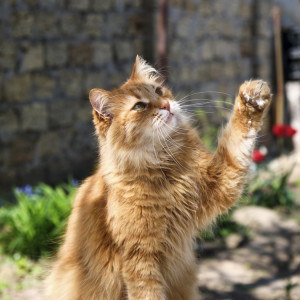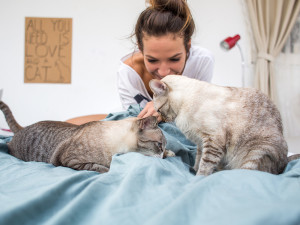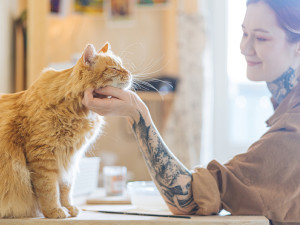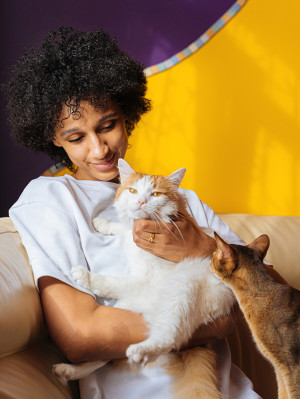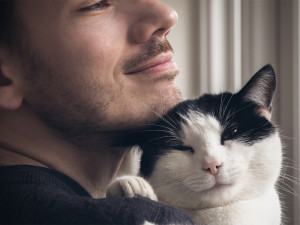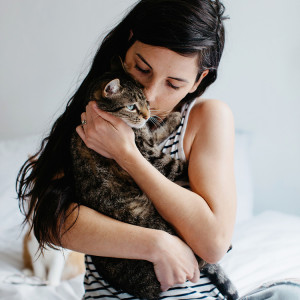Can Cats Cry? How to Decipher Cat Crying
They aren’t exactly going to weep over a rom-com marathon with you, but here are the reasons your kitty could shed a tear.
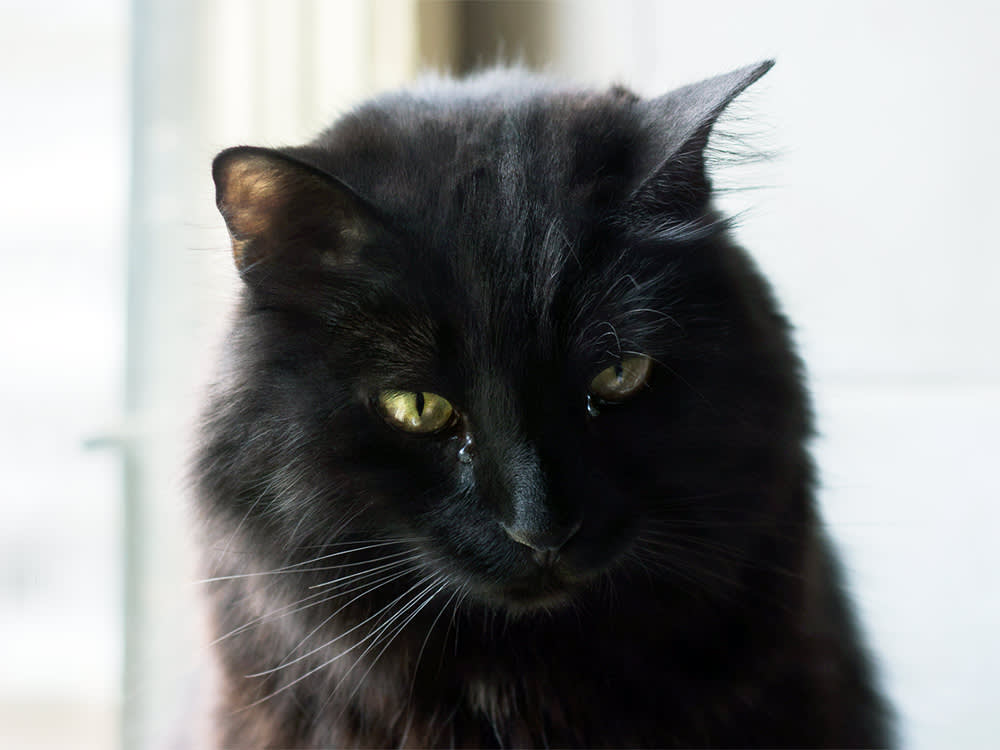
share article
In This Article:
Do Cats Have Tear Ducts?opens in a new tab Can Cats Cry Tears? opens in a new tab Reasons for Watery Cat Eyesopens in a new tab My Cat’s Eyes Water When Sad or Scared opens in a new tab Can Cats Produce Tears When in Pain? opens in a new tab
If you are in servitude to a cat, you know that they are highly emotional and intelligent creatures, expressing a wide range of feelings and desires. And while many of us have witnessed our cats “crying,” especially if it has been more than five minutes since their last meal, they don’t actually shed tears when they are wailing for food or experiencing other distressing events. A cat’s eyes will produce tears because of illness, injury, or irritants like dust, triggering tear production.
When we think of a human crying, we often associate it with both tears and vocalizations like wails, sobs, and screams. Interestingly, humans are the only creatures that shed tears for emotional reasons. For all other animals, watery eyes are not a sign of emotional distress but rather a medical problem.
That said, cats can certainly express emotionsopens in a new tab in other ways so even though they don’t shed emotional tears, they can make their feelings known. Read on to learn more about how cats cry.
Do cats have tear ducts?
Yes, cats have tear ducts, and their anatomy is quite similar to ours. The primary function of tears is to keep the surface of the eye moist. This is accomplished by releasing a combination of watery, oily, and mucus-like secretions from glands around the eye to create a tear film that constantly coats the surface of the eye.
This combination of secretions helps the tears to stick to the surface of the eye. Tears then drain from the eye through the nasolacrimal ducts into the nose. The nasolacrimal duct is the fancy anatomical term for the tear duct. There are tiny openings for the ducts at the inner corners of the eyes closest to the nose and the duct is almost like a little tube that allows these fluids to flow down into the nose.
Can cats cry tears?
Cats can have visible tears coming out of their eyes, but this does not happen for emotional reasons, so it is not referred to as crying. Instead, some underlying cause leads the eyes to either have excessive tear production, or a problem with the tears draining normally. This can lead to eyes that look watery or have tears dripping down. This is known as epiphora, which is the technical medical term for watery eyes.
Reasons for watery cat eyes
Watery eyes are caused either by an overproduction of tears or by problems with the tears draining normally. This can happen for a variety of medical reasonsopens in a new tab. Some common reasons for watery eyes include:
Eye infections: Cats frequently develop conjunctivitisopens in a new tab, an eye infection of the outer surface of the eye, known as the conjunctiva. This is frequently caused by a cat virus called feline herpesvirus 1 or rhinotracheitis. It is a highly contagious virus opens in a new tabthat many cats will contract, especially if they have been around other cats such as in a shelter or outside in a cat colony. It may include other signs like sneezing, congestion, and/or a decreased appetite. They can also develop eye infections due to bacterial or fungal causes, too.
Eye injuries: Injuries to the eye can also cause eyes to water excessively. This can happen if there is a scratch or ulcer on the surface of the eye, foreign material stuck in the eye, or injuries to the eyelids.
Eye irritants: Tears can be a protective response to anything that irritates the eyes. This can happen when there is a lot of dust in the air, for example, or with other irritants like smoke, or spices from cooking such as hot chilis or onions that are being chopped.
Dry eye: This one may be counterintuitive, but sometimes, when a cat is not making adequate tears, they will actually look like their eyes are more watery or tearing. This is because the combination of tear secretions is out of balance and the tears don’t stick to the surface of the eye like they should, but instead drip down. This condition is known as keratoconjunctivitis sicca, or KCS, or dry eye. It can be a congenital or acquired condition.
Eyelid abnormalities: Conditions of the eyelid, such as an eyelash that rubs on the surface of the eye, or eyelids that are abnormally shaped, can also lead to irritation of the eye, and cause tearing.
Blocked tear ducts: If you envision the tear duct like the drain and pipes under your sink, you can imagine that if the duct is clogged or blocked in some way, the tears cannot drain through the tube the way they normally should, but instead overflow out of the eye like tears. This can happen if there is debris stuck within the duct, if the duct is not formed properly, or if scar tissue develops in the duct. Some breeds, like Persian cats, are more prone to these problems due to the anatomy of their smushed faces.
My cat’s eyes water when scared or sad
This is most likely a coincidence. Cats are not known to shed tears as a result of emotional distress like being sad or scared; however, they can certainly exhibit those emotions. If your cat is distressed for an obvious emotional reasonopens in a new tab, like a sudden change in their environment, loss of a companion, addition of a new pet to the house, or disruptions like construction in the home, you may notice a lot of changes to your cat’s behavior.
They may hide more, eat less, groom themselves less, or act extra clingyopens in a new tab with you. These behavior changes are all signs of their distress, and they may need your support to adjust. Try giving your cat a quiet, safe space with their food, water, and litter box to allow them time to adjust.
You can also use tools, like pheromone diffusersopens in a new tab, catnip, and/or extra special toysopens in a new tab to help lure your cat into socializing and coming out of hiding. If you are noticing that your cat’s eyes are constantly tearing, or they have any other physical signs of illness like sneezing, eye discharge, persistently low appetite, or any other sudden changes, see your vet first to rule out a medical problem.
Can cats produce tears when in pain?
Not usually. The most common signs of painopens in a new tab in a cat are vocalizing, hiding, decreased appetite, and decreased grooming. Some cats will also show signs of aggression such as hissing, growling, biting and/or scratching if their painful spot is touched. When there is a painful injury to the eye, a cat is likely to produce tears.
This is not an emotional response but rather a protective response by the eye. For example, if a cat gets a foreign object like dust in their eye, it causes irritation and pain on the very sensitive cornea of the eye. The eye produces more tears as a response, and this helps to flush out the surface of the eye and push out the foreign object.
When to see the vet about watery eyes
If your cat’s eyes are watering for more than just a few hours, it’s a good idea to see a vet.opens in a new tab Also, if you notice any other signs of a medical problem, such as crusting or red eyes, eye discharge, swollen eyes, eyes that are sealed shut, or your cat is rubbing at their eyes, see a vet right away. Because cats do not shed tears for emotional reasons, watery eyes are a sign of a medical problem.
Whether it is as simple as something irritating the eye, or a more chronic problem with their tear production or tear drainage, all of these problems can be identified and treated by your vet. Eyes are both extremely delicate and extremely important, so it’s critical to have any possible eye problems diagnosed and treated right away.opens in a new tab
The risk of taking a wait-and-see approach with eye problems is that they can result in long term damage to the eyes, possibly affecting your cat’s vision. The sooner they are treated, the sooner your cat will get relief from their discomfort and the more likely they are to avoid long-term damage.
Commonly asked questions:
Can a cat cry real tears?
Cats do shed real tears, however, only for medical reasons, not for emotional ones.
How do cats express sadness?
Sadness usually results in behavioral changes, including hiding, eating less, grooming less, acting more clingy or less interested in playing.
Can cats cry out of sadness?
Cats do not shed tears for sadness, but they can vocalize and make sounds that we often refer to as “crying.”
References:
Clinical Autonomic Research: The Neurobiology of Human Cryingopens in a new tab
Merck Veterinary Manual: Eye Structure and Function in Catsopens in a new tab

Dr. Amy Fox, DVM
Amy Fox, DVM is a small animal veterinarian in New York City. A lifelong animal lover, Dr. Fox studied biology in college and then worked as a veterinary nurse before pursuing veterinary school at Cornell University. She has worked in many different settings including shelter medicine, emergency medicine, general practice, and animal cruelty and forensics. She is especially interested in nutrition, preventative medicine and care for senior pets. Dr. Fox also enjoys writing about veterinary medicine and teaching. In her free time she loves to cook, garden, and go for long runs.
Related articles
![A woman with curly black hair sitting in front of a dark purple and yellow backdrop while looking down affectionately at her two cats sitting on her lap]() opens in a new tab
opens in a new tabHow to Build Your New Cat’s Trust in You
If your cat still approaches you with a figurative arched eyebrow of skepticism, try these tricks to put them at ease.
![cat snuggling man]() opens in a new tab
opens in a new tabWhat’s Your Cat’s Love Language?
Five surprising ways cats show affection (and how you can show it back), according to a cat behaviorist.
![dark-haired woman hugging cat that has imprinted on her]() opens in a new tab
opens in a new tab10 Signs Your Cat Has Imprinted on You
Feeling like you have a little shadow these days? Here’s why that’s happening.
![]() opens in a new tab
opens in a new tabThis Study Says You Literally Can’t Hide From Your Cat
Happy spooky season.
![White and light brown cat laying down with eyes almost closed]() opens in a new tab
opens in a new tabStudy Says “Slow Blinking” at Your Cat Helps You Bond
A team of psychologists at the Universities of Sussex and Portsmouth have discovered the key to building a bond with cats.
![]() opens in a new tab
opens in a new tabHow to Read Your Cat’s Poker Face
A guide to their not-so-secret tells.
